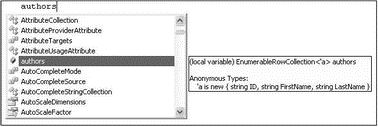Книга: C# 2008 Programmer
Reshaping Data
Reshaping Data
Using the new anonymous types feature in C# 3.0, you can define a new type without needing to define a new class. Consider the following statement:
//---query for authors living in CA---
var authors =
from author in ds.Tables[0].AsEnumerable()
where author.Field<string>("State") == "CA"
select new {
ID = author.Field<string>("au_id"),
FirstName = author.Field<string>("au_fname"),
LastName = author.Field<string>("au_lname")
};
Here, you select all the authors living in the CA state and at the same time create a new type consisting of three properties: ID, FirstName, and LastName. If you now type the word authors, IntelliSense will show you that authors is of type EnumerableRowCollection<'a> authors, and 'a is an anonymous type containing the three fields (see Figure 14-6).

Figure 14-6
You can now print out the result using a foreach loop:
foreach (var row in authors) {
Console.WriteLine("{0} - {1}, {2}",
row.ID, row.FirstName, row.LastName);
}
To databind to a DataGridView control, you first must convert the result of the query to a List object:
//---query for authors living in CA---
var authors =
(from author in ds.Tables[0].AsEnumerable()
where author.Field<string>("State") == "CA"
select new {
ID = author.Field<string>("au_id"),
FirstName = author.Field<string>("au_fname"),
LastName = author.Field<string>("au_lname")
}).ToList();
//---bind to a datagridview control---
dataGridView1.DataSource = authors;
- LINQ to DataSet
- Saving the Result of a Query to a DataTable
- Информация заголовочной страницы (Database header)
- Database dialect
- DATABASE CACHE SIZE
- Data sending and control session
- SCTP DATA chunk
- Data Binding Using the GridView Control
- Interbase DataPump
- GetDataBack
- Работа с DataRow
- 16.8. Реализация отношений в Core Data




